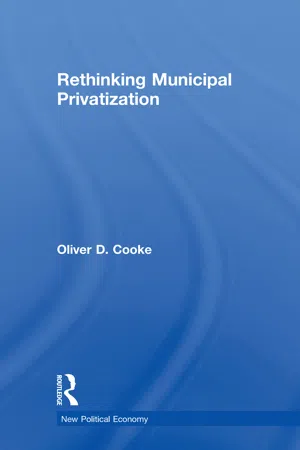Business
Privatization
Privatization refers to the transfer of ownership and control of a business or industry from the public sector to the private sector. This often involves selling state-owned enterprises to private investors or allowing private companies to take over the management and operation of public services. The goal is to improve efficiency, reduce government involvement, and stimulate economic growth.
Written by Perlego with AI-assistance
Related key terms
10 Key excerpts on "Privatization"
- eBook - ePub
Privatization
An International Review Of Performance
- Graeme Hodge(Author)
- 2018(Publication Date)
- Routledge(Publisher)
Not surprisingly, therefore, many others see Privatization as narrower still—simply as die sale of public enterprises (or denationalization) or as a shift from pubhe to private provision of goods through, for example, contracting out while maintaining public funding. Under this philosophy "Privatization is the transfer of assets and/or service functions from public to private hands. It includes therefore activities that range from selling State Owned Enterprises to contracting out public services with private contractors." 8 This latter definition will be adopted in this book. Although it follows the mainstream of international references, it is recognized that viewing Privatization as including both the sale of public enterprises and the contracting out of public services could be quite different from the common meaning attached to Privatization in some countries, such as Australia or New Zealand - eBook - ePub
- Oliver D. Cooke(Author)
- 2007(Publication Date)
- Routledge(Publisher)
A system of state (rather than private) ownership and operation of industrial enterprises and state planning (rather than markets) amounted to a shift from a private to a state form of capitalism.” 22 In the context of the Privatization of state-owned enterprises, the argument here can be interpreted as reversing the words private and state in the italicized portion of the just-quoted passage, viz., the Privatization movement that has so forcefully emerged over the course of the past quarter-century has generally involved transforming state-owned capitalist enterprises into privately-owned capitalist enterprises. To be clear, from a class perspective, any Privatization involving the transfer of state-owned enterprises to the private sector is understood to involve a host of changes in a number of economic, political, cultural, and natural processes. Moreover, such changes undoubtedly cascade across the social environment (within which the Privatization takes place) in complex and contradictory ways. At the same time, the Privatization programs that have been carried out around the world over the course of the past quarter century have, in general, not involved any change in the class structures of the state-owned enterprises that have been privatized. Whereas prior to Privatization, state administrators or bureaucrats (or, boards of individuals appointed and/or closely connected to them) appropriated and then distributed the surpluses produced by the productive wage laborers employed (by the government) in state-owned enterprises, following Privatization, this appropriation and distribution has been carried out by a different group of private individuals—generally, the board of directors of the private capitalist enterprises that have often become responsible for the operation of newly-privatized enterprises - eBook - ePub
Just Get Out of the Way
How Government Can Help Business in Poor Countries
- Robert E. Anderson(Author)
- 2004(Publication Date)
- Cato Institute(Publisher)
4. Privatization: Just Sell It
A central element of any program to develop the private sector is that the government should transfer commercial activities now carried out by state-owned enterprises or government agencies to the private sector. Since the early 1980s, many poor countries have privatized state-owned enterprises, in other words, transferred ownership to private investors. There is widespread agreement that stateowned enterprises have performed badly and that privatized companies have usually performed better. I will not attempt to summarize the hundred or more studies that provide empirical data that demonstrate this conclusion.1 Few now argue, at least publicly, that Privatization is a poor policy.Given this acceptance of the need to privatize state-owned enterprises, one would expect that there is widespread agreement on both the objectives of Privatization and the methods of Privatization that best achieves those objectives. Instead, the voluminous literature on Privatization contains a bewildering list of objectives. Similarly, numerous methods or techniques of Privatization have been used, including trade sales, initial public offerings, management-employee buyouts, voucher Privatization, and capitalizing pension funds.In contrast to most other issues in economic development, international development agencies, consultants, and academics do not seem to have reached a consensus on what the objectives of Privatization ought to be and what methods will best achieve those objectives. The prevailing view seems to be that each country is unique and the objectives and methods of Privatization need to be tailored to the specific circumstances of each country.The following is typical of what is written about Privatization: ‘‘Privatization is neither a simple or a uniform process. Starting points differ; countries have varying objectives, face a wide and shifting range of problems and obstacles, and thus need to adopt different strategies and tactics to achieve their Privatization objectives. There is no universally applicable approach to Privatization, and the attempt to apply a ‘one size fits all’ has proved ineffective and counterproductive.’’2 - INTERNATIONAL MONETARY FUND(Author)
- 1989(Publication Date)
- INTERNATIONAL MONETARY FUND(Publisher)
More generally, what are the broad effects of Privatization on overall macroeconomic performance? Would the Privatization process help or hinder the national authorities in their pursuit of macroeconomic goals? There is an implicit assumption in the paper that Privatization would help. If so, the required conditions need to be spelled out. The question of Privatization can only be considered in the context of the overall national economic performance.Privatization, it is argued, would permit enterprises to become more efficient and productive. This is often the case. But where do we draw the line between the public and private sectors? Can we state, for example, that all income-generating public enterprises are candidates for Privatization on the assumption that the private sector is more efficient than the public sector? One precondition put forward in this connection is that a competitive environment should prevail. Would oligopolistic enterprises fit into the process of Privatization? What about situations where public ownership is maintained but management is entrusted to the private sector through leasing and management contracts? The authors state that Privatization is not necessarily optimal for all countries, presumably because competitiveness of markets, among other criteria, are not guaranteed. Perhaps they can elaborate on this point in relation to the respective domains of the public and private sectors.Finally, I refer to the World Bank experience. While headway has been made in a number of countries, Bank experience points to a relative slowness in the process of Privatization. Was this all due to a lack of the necessary preconditions? Or could there also have been other factors that hindered the process and what were they? Does World Bank experience shed light on this question?Furthermore, if it is true that the motives behind the emergence of public enterprises were also social and political and not simply economic, it follows that a change in the sociopolitical attitude of the countries concerned must take place to ensure the longer-term success of Privatization. In other words, among the preconditions for success that the authors enumerate (prior restructuring, enhancement of managerial capacity, etc.), a change in the political environment may also have to be listed. Is this borne out by World Bank experience?- eBook - ePub
- Colin Crouch(Author)
- 2013(Publication Date)
- Polity(Publisher)
In previous chapters we have considered the need to distinguish between the market and control by large enterprises. We also encounter this distinction when considering the two concepts of Privatization and marketization. Marketization implies offering a good or service for sale, placing it in the market under all the conditions discussed above. By itself, this does not necessarily imply private ownership of the means of production; it has long been possible for services to remain in public ownership, and even to remain delivered by public agencies, but for consumers to obtain them through purchase. The quality and quantity of their provision can then be governed by consideration of the prices that consumers are prepared to pay. Alternatively, marketization can be a process carried on within an organization, whether in the public or private sector; the markets that are imposed in such cases are known as ‘internal’ markets. Organizations of all kinds have a choice as to how they allocate resources among their different departments. There may be a system of decisions by the organization’s leadership, based on certain principles and desired outcomes, often preceded by a process of bargaining with the departments; or the leadership may permit market forces to determine how these resources flow. Often there is a combination of the two, with market forces operating only after the leadership has fixed certain parameters, such as prices.Marketization must therefore be distinguished from Privatization, which refers to selling or otherwise handing to private owners the assets of a formerly public service. This, in turn, might or might not imply marketization; a public service can be sold to a private monopoly, with ultimate consumers having little or no ability to affect the provision through their market behaviour. An important factor encouraging Privatization has been that it would enable governments to attract private finance into the funding of major capital projects, instead of relying on taxation or public debt.True markets have rarely accompanied these Privatizations, problems of oligopoly and limited opportunities for competition usually having been important reasons why these activities had ended up in the public domain in the first place. An example of unsatisfactory Privatization to a monopoly took place in the UK in the solution adopted for railway track provision and maintenance, where Privatization was considered to create problems of rail safety. The track was therefore placed into an unusual form of ownership, designed to avoid giving the appearance of renationalization, while also avoiding the market failures of a monopoly. An organization called Network Rail was created, which calls itself a private company acting on a commercial basis. But it was established by government, has no shareholders, and reinvests all its profit into the rail network. Its board comprises ‘members’ appointed from the rail industry and from users. It is subject to a regulatory agency, the Office of Rail Regulation (ORR), and it is underwritten by the government. Provision of rail services - eBook - ePub
The Impact of Privatization
Ownership and Corporate Performance in the United Kingdom
- Stephen Martin, David Parker(Authors)
- 1997(Publication Date)
- Routledge(Publisher)
1 PRIVATISATION
The conceptual framework
INTRODUCTION
In the last decade many countries have introduced privatisation programmes. In 1995 the value of state selloffs is reported to have reached a record figure of US$73bn with at least forty-five countries in the process of privatising some industries (Economist, 13 January 1996, p. 5). This figure may exaggerate the degree of true privatisation since some governments choose to describe the sale to the private sector of only a small part of the total shareholding as a privatisation. Nevertheless, there can be no doubting the profound effect of world-wide privatisation on industrial organisation both in the developed and the developing world.Table 1.1 UK privatisation proceedsThis book is concerned with privatisation in the UK where, since 1979, over £60bn of UK business assets have been transferred from the state sector to the private sector. At first the annual value of sales was low but, as reflected in the figures in Table 1.1 , since the mid-1980s sales have regularly exceeded £5bn per annum, reaching a figure of over £8bn in 1992–3. Table 1.2 provides a summary listing of the main industrial privatisations since 1979 in the UK. Whole industries, such as water, electricity and gas supply, have been affected, along with large sections of the transport, aerospace and telecommunications industries. Because of the size and scope of the privatisation programme, the UK is an obvious candidate for studying the economic effects of this policy. Also, sufficient time has now passed since the early privatisations to begin to assess their longer-term economic impact.Table 1.2 Major privatisations in the UKIn the UK, as in many other countries, the political pressure for privatisation came from a combination of disillusionment with the results of state ownership and from a belief that private ownership would bring substantial economic benefits. State-owned industries were viewed as highly inefficient, slow at developing and introducing new technologies, subject to over-frequent and damaging political intervention and dominated by powerful trade unions (Veljanovski, 1987). Privatisation seemed to offer a means of ridding the state of the financial burden of loss-making activities, while at the same time spreading share ownership and curtailing union power (Arbomeit, 1986). Moreover, privatisation sales offered a tempting source of state funding at a time when economic policy was geared to reducing the public sector borrowing requirement (PSBR). - eBook - ePub
Privatization and Entrepreneurship
The Managerial Challenge in Central and Eastern Europe
- Erdener Kaynak, Alfred Lewis, Arieh A Ullmann(Authors)
- 2018(Publication Date)
- Routledge(Publisher)
PART II: MANAGEMENT CHALLENGES OF PrivatizationPassage contains an image Chapter 5 Managerial Implications of the Transition from Public to Private Ownership in Central and Eastern Europe: Are Managers Equipped to Compete? Douglas L. BartleyMichael S. Minor
One of the major shifts in economic activity across the globe in the last decade has been the transition from state-owned enterprises (SOEs) to private enterprises. No region has felt the effects of this transition more acutely than the nations of Central and Eastern Europe and the former Soviet Union.Since the fall of the communist governments, initiatives were started to privatize most of the SOEs (Chubais, 1993; Komai, 1992; Minor, 1993, 1994; Sachs, 1992; World Bank, 1992). The speed of this transition has varied by country and by industry. Generally speaking, Privatization implied a transfer of ownership of productive assets from the state to private parties. “The effect of this move was expected to be a transition from one idealized state of affairs to another: from the ‘command’ to a ‘market’ economy” (Frydman and Rapaczynski, 1994: 169).One major problematic element of the transition “from one idealized state to another” is management experience needed in a market economy at various levels of the enterprise. MANAGERSUnder the command system, decision making was carried out through the “Bermuda triangle” of ministry, workers’ council, and trade union council (Bilsen, 1994); even operating decisions were made in government offices and transmitted to those responsible for day-to-day operations. Besides the dependence on ministerial directives, the major operational problem was obtaining inputs. Product quality or financial performance were minor concerns.Now decision making is being transferred to plant level management. Are these managers prepared to make effective decisions in a timely fashion? Most companies lack data to aid their decision making and have only the vaguest notions of whether products meet customer needs, at what price, in what volume, and at what location. Coupled with this lack of information is the inexperience of the general management of the new enterprise, especially with regard to decision making. “Nothing so much frightens people in former Communist countries, visitors report, as to be asked to make a decision. They are paralyzed by fear of making a mistake” (Dumitriu and Nicolaescu, 1994: 153). - eBook - ePub
- V. V. Ramanadham, V. V. Ramanadham(Authors)
- 2002(Publication Date)
- Routledge(Publisher)
There will be continuing needs of an interface between the bureaucrats and the enterprises, but this has to be qualitatively very different from the command-type interventions of the public enterprise and central planning era. ‘Owners’ as a class have to be born and bred. Managers whose focus was on meeting the commands from above have to learn to behave by market disciplines. 43 And workers who exercised varying degrees of control over the enterprise, to its detriment by and large, and who have generally been characterized by poor work ethics, have to change into partners in enterprise activity, willingly exposing themselves to the risks of the market. 44 The learning curve is, on the whole, a lengthy one. True, the pace of Privatization might not be too restrained for this reason, in view of overriding political compulsions. But constraints reveal themselves in two important respects, viz. the techniques of Privatization and the success of Privatization. Improvements in infrastructural conditions and the parallel requisites, discussed earlier, can soften the constraints. But then they are, by nature, more long term in prospect. Policy formulation and implementation Policy statement A clear statement of policy concerning Privatization—its connotation, objectives, options, techniques, implications and sequencing—smooths the process as well as prepares the relevant constituencies for a common understanding of what to expect. This condition, necessary but not sufficient, for successful Privatization has not been satisfied in many countries - eBook - ePub
Limits to Privatization
How to Avoid Too Much of a Good Thing - A Report to the Club of Rome
- Marianne Beishem, Oran R Young, Ernst Ulrich von Weizsacker, Matthias Finger(Authors)
- 2012(Publication Date)
- Routledge(Publisher)
Several general themes emerge from this analysis. Recent trends towards Privatization within countries constitute understandable responses to past problems. Yet, the limits to Privatization are becoming increasingly apparent. Private actions at their best cannot solve collective action problems in the absence of rules of the game that are widely understood and generally regarded as legitimate. Overarching problems, such as instabilities in global trade and financial regimes, the growth of disparities between the rich and the poor, and the onset of global environmental changes, will profoundly affect the consequences flowing from domestic initiatives involving Privatization and deregulation. For the most part, individual countries will not be in a position to solve these global problems. But ignoring them in efforts to make use of Privatization successfully at the domestic level can, and often will, lead to disaster.Passage contains an image The Regional Context Privatization in G7 Countries Matthias Finger
This section considers the phenomenon of Privatization in the G7 countries (i.e. the US, Canada, the UK, Japan, France, Germany and Italy).1 It shows that Privatization varies significantly from country to country, but especially between industrialized and developing countries. With the exception of the UK, and to a lesser extent Italy, Privatization is not (yet) a significant phenomenon. Furthermore, the US must be treated separately, as well as Canada (although to a lesser degree), which displays some similarities with France, Germany and Italy.OverviewThe term ‘Privatization’ was popularized by the sale of British Telecom in 1984, and became quite mainstream throughout the rest of the decade. The process began during the late 1970s, with the Thatcher government in the UK, and spread across countries and continents. From 1977 to 1999, 2459 deals in 121 countries with approximately US$1110 billion worth of proceeds of sales were reported (Siniscalco and Fantini, 2001). Of the 34 countries studied for the 1977–1999 period, Sri Lanka is the only country which never implemented any major Privatization, while the UK leads the ranking with 169 operations. Turkey leads the less developed countries, with 60 operations. - eBook - ePub
Bigger Economies, Smaller Governments
The Role Of Privatization In Latin America
- William Glade(Author)
- 2019(Publication Date)
- Routledge(Publisher)
The overwhelming majority of those who favor Privatization firmly believe that private enterprises are more efficient than state-owned firms. The notion behind this concept is that, given the incentives they are subject to, the former are able to produce more for a given level of inputs, or to produce a certain output with fewer inputs. For example, Hanke provides an impressive list of examples of the superior internal efficiency of private enterprises: administrative functions in the United States; airlines and banking in Australia; cleaning services in the United States and Germany; electricity generation and fire protection in the United States; forestry services in Germany; hospital services, postal services, property evaluation services, railroads, garbage collection, road maintenance, urban transport, water supply, and weather forecasting in the United States; and so on. In each of these cases, private enterprise performed significantly better than comparable state-owned firms.Others, however, argue that in many cases Privatization has not fulfilled expectations. For example, Bailey describes four cases in New York in which this was so: commercial refuse, proprietary vocational education, school transportation, and the management of sports facilities.In fact, it can be proven, as Vickers and Yarrow do, that from a theoretical point of view, “the relative performance of publicly owned firms in respect of allocative and internal efficiency will depend upon a range of factors that includes the effectiveness of the respective monitoring systems, the degree of competition in markets, regulatory policy, and the technological progressiveness of the industry.” These same authors, after reviewing the empirical evidence available at the time, conclude that “ownership matters,” that “where firms face little market competition and are extensively regulated, there is no generally decisive evidence in favor of one or other type of ownership,” whereas “in industries where public ownership predominates and where one of the goals of public policy is to promote greater competition, the available evidence offers some support for certain types of Privatization policies.” Overall, they maintain that “where product markets are competitive, it is more likely that the benefits of private monitoring systems will exceed any accompanying detriments in allocative efficiency.”Most of the existing empirical evidence cited by Hanke, Bailey, Vickers and Yarrow and others is either from the United States or from other developed countries and compares existing private and state-owned enterprises (SOEs). Very few studies actually focus directly on the effect of Privatization on efficiency. Yarrow attempts to measure this effect in the case of Great Britain by observing the behavior of series of data for each enterprise, such as rates of return, tariffs or fares, and output levels before and after Privatization. In so doing, he looked for “kinks” in the trends of those series of data at or around the time of Privatization. He concluded that in Great Britain there was a tendency for the performance of some SOEs to improve before
Index pages curate the most relevant extracts from our library of academic textbooks. They’ve been created using an in-house natural language model (NLM), each adding context and meaning to key research topics.









